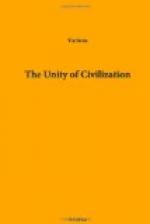From their time down to our own, then, this conception of art, as being coloured or affected strongly and continually by nationality, has become almost a commonplace of criticism, and it will not be denied that there is real importance in the conception. For though nothing is really art which is not distinctive and personal and unique, yet just so far as the personality of the artist is conditioned by his nationality, so far also will his artistic work reflect the characteristics of his nation or country. And yet, while this is true, it really needs very little consideration to see that when we consider a great work of art, we are very little concerned with the question of the nationality of the artist, but with something which is deeper and larger than his nationality. The great artist no doubt represents life under the forms or terms of his concrete experience, but it is life and the world itself which he represents. He is not greatly concerned with the merely superficial or passing aspects of human nature and the world, but with that which is essential and continuing under these terms.
It may indeed be urged that there is some real and fundamental difference between the art of the East and that of the West, but as we have come to know eastern art better, we have become more doubtful even of this, and are rather impressed with the unity of the artistic expression even of East and West. I am far from wishing to say that nationality or race has no significance in art, but I think that we have been in danger of greatly exaggerating its importance. I am at least certain that we have very constantly made too much of the supposed differences in the literature and art of the different European countries, and that we must make clear to ourselves that European art and literature are really one.
It is not unimportant to observe this at the present time, to consider whether literature and art are dividing or uniting forces. As far as we can understand, what indeed seems a little unintelligible, the Germans desire to impress upon Europe their culture or civilization, an attempt as absurd as it would be impossible, for German culture is, after all, only a part of the great European civilization, and the part cannot take the place of the whole. But on the other hand it is not less important for us to understand that what we desire to do is not to destroy those elements which Germany contributes to European civilization, but only that they should take their natural and appropriate place in that greater unity which is enriched and enlarged by the contribution of every separate national society. European art is one; that is, the common characteristics are far more important than the national differences. And further, we often take to be national, characteristics which happen to show themselves at one time in one place, while they may have existed at another time in another place. The history of European art is in a great measure the history of successive influences or movements which were for the most part common to all Europe, but which did not always exactly synchronize in the different European countries.




